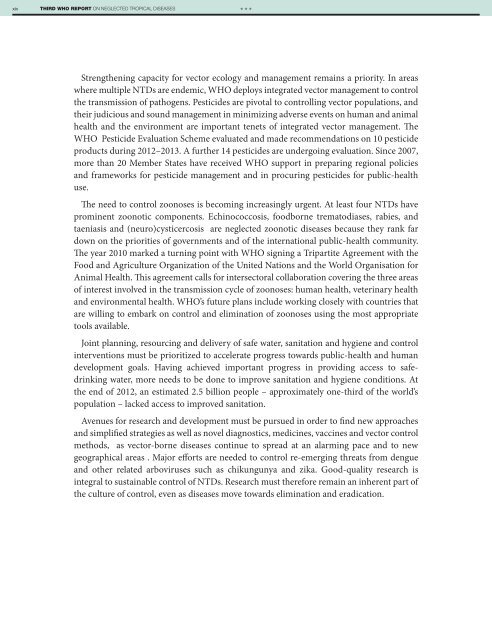1A9bnbK
1A9bnbK
1A9bnbK
You also want an ePaper? Increase the reach of your titles
YUMPU automatically turns print PDFs into web optimized ePapers that Google loves.
xiv THIRD WHO REPORT ON NEGLECTED TROPICAL DISEASES<br />
***<br />
Strengthening capacity for vector ecology and management remains a priority. In areas<br />
where multiple NTDs are endemic, WHO deploys integrated vector management to control<br />
the transmission of pathogens. Pesticides are pivotal to controlling vector populations, and<br />
their judicious and sound management in minimizing adverse events on human and animal<br />
health and the environment are important tenets of integrated vector management. The<br />
WHO Pesticide Evaluation Scheme evaluated and made recommendations on 10 pesticide<br />
products during 2012–2013. A further 14 pesticides are undergoing evaluation. Since 2007,<br />
more than 20 Member States have received WHO support in preparing regional policies<br />
and frameworks for pesticide management and in procuring pesticides for public-health<br />
use.<br />
The need to control zoonoses is becoming increasingly urgent. At least four NTDs have<br />
prominent zoonotic components. Echinococcosis, foodborne trematodiases, rabies, and<br />
taeniasis and (neuro)cysticercosis are neglected zoonotic diseases because they rank far<br />
down on the priorities of governments and of the international public-health community.<br />
The year 2010 marked a turning point with WHO signing a Tripartite Agreement with the<br />
Food and Agriculture Organization of the United Nations and the World Organisation for<br />
Animal Health. This agreement calls for intersectoral collaboration covering the three areas<br />
of interest involved in the transmission cycle of zoonoses: human health, veterinary health<br />
and environmental health. WHO’s future plans include working closely with countries that<br />
are willing to embark on control and elimination of zoonoses using the most appropriate<br />
tools available.<br />
Joint planning, resourcing and delivery of safe water, sanitation and hygiene and control<br />
interventions must be prioritized to accelerate progress towards public-health and human<br />
development goals. Having achieved important progress in providing access to safedrinking<br />
water, more needs to be done to improve sanitation and hygiene conditions. At<br />
the end of 2012, an estimated 2.5 billion people – approximately one-third of the world’s<br />
population – lacked access to improved sanitation.<br />
Avenues for research and development must be pursued in order to find new approaches<br />
and simplified strategies as well as novel diagnostics, medicines, vaccines and vector control<br />
methods, as vector-borne diseases continue to spread at an alarming pace and to new<br />
geographical areas . Major efforts are needed to control re-emerging threats from dengue<br />
and other related arboviruses such as chikungunya and zika. Good-quality research is<br />
integral to sustainable control of NTDs. Research must therefore remain an inherent part of<br />
the culture of control, even as diseases move towards elimination and eradication.


